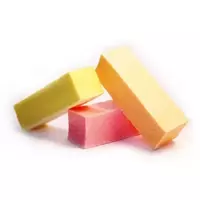Fruit candy

The first mention of pastille dates back to the 14th century, when the people of Kolomna began making it from apple puree, which was thoroughly whipped, and berry pulp. Mostly it was mountain ash, currants, raspberries and lingonberries, and from apples they used exclusively sour, originally Russian varieties - antonovka, green or titka. The second ingredient in the pastille was natural honey, which was subsequently replaced by sugar sand. In the 15th century, a third component appeared in the pastille. It was chicken egg protein, giving the treat a white hue.
Due to its excellent taste and unmatched aroma, pastille is consistently very popular around the world. It is enjoyed during tea parties not only as usual, but also as a component of a wide variety of desserts, cakes and cakes. In our country, for example, according to tradition, pastille is served with warm milk, tea with honey or any wine of dessert varieties.
In addition, France is characterized by eating this delicious product with champagne, white wine or milkshakes. English people prefer to enjoy a pastille with a cup of fragrant coffee or whipped cream - while the delicate sweetness is cut into thin slices, and decorated with a leaf of fresh mint on top. In Spain, they love to feast on pastille with black coffee, goat's milk and tangerine jelly, and in Dutch restaurants you will definitely be offered green tea with jasmine, which is relied on for a slice of pastille, as well as melted cheese watered with caramel.
Types of pastille
In general, two types of pastilles are distinguished, which depend on the composition of this product. This is adhesive pastille, which is produced in the form of rectangular bars based on pectin-molasses or agar-molasses syrup, as well as custard pastilles made from sugar-apple-marmalade mass.
In addition, based on the molding methods, there are 3 types of pastilles. Bars of rectangular cross-section represent carved and layer pastille, and roll pastille is made in the form of oblong loaves composed of spirally coiled layers. The calorie content of the pastila is 324 kcal per hundred grams.
Pastila composition
Today, the composition of the pastille is as follows: fruit puree (mainly apple), sugar, flour (for bonding), as well as animal products, in particular chicken eggs. In addition, some manufacturers add flavors and colors (both natural and synthetic), preservatives, flavor enhancers, fillers and emulsifiers to the pastille.
The benefits of pastila
When they talk about the benefits of pastila, they imply a product prepared according to a traditional recipe, which does not provide extraneous additives. It is recommended to use such a pastille in the morning at breakfast, since due to the presence of a huge amount of useful substances, in particular easily digestible carbohydrates, a person receives the necessary charge of vigor for the whole day.
pastilles 324 kCal
Energy value of pastila (Ratio of proteins, fats, carbohydrates - ju):
Proteins: 0.5 g (~ 2 kCal)
Fats: 0 g (~ 0 kCal)
Carbohydrates: 80g (~ 320 kCal)
Energy ratio (bj | y): 1% | 0% | 99%
 Español
Español Français
Français Português
Português Русский
Русский 简体中文
简体中文 繁體中文
繁體中文 日本語
日本語 한국어
한국어 العربية
العربية Türkçe
Türkçe Қазақ
Қазақ Deutsch
Deutsch Italiano
Italiano Українська
Українська
